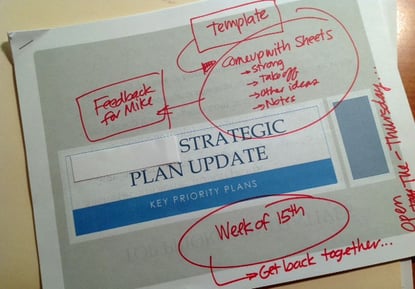Mid-year is that time where you look ahead to the year’s end while simultaneously reviewing this year’s plan and wondering how everything will get done by December 31. That leads to asking, “What would happen if we don’t get everything done? Didn’t we put too many things into the plan, anyway?”
Sound familiar?
5 Areas to Get Stalled Strategic Planning Initiatives Moving

I used to go through this routine repeatedly until I realized that I lacked a standard checklist of project assessment questions to use when a strategic planning initiative is behind schedule. I guess I was recreating the question set every time I needed it.
To spare yourself and everyone around you the hassles involved with not working from a standard set of questions, you can use the following routine this week, and in the years ahead, to standardize your diagnoses and approaches to floundering projects.
Rank the Suspected Causes
The first step is to assess the potential reasons why a strategic planning initiative hasn’t started within the time frame you originally planned. We recommend making a quick assessment. Our approach is to rank potential factors based on which you think are the most-to-least significant in delaying launch. Some typical factors you may consider:
- The initiative’s importance or fit within the plan is off or no longer relevant
- The leader and/or team on the initiative isn’t the right one
- There’s an issue with the structure of the approach the team is taking to the initiative
- There’s an issue with the size or scope of the initiative
- Resource availability or levels are a roadblock
- Some other reason is creating the roadblock
Ranking these factors, 1 through 6, helps prioritize your starting place to address the initiative’s delay. One ground rule: there can be no ties in your ranking. Not EVERY item can be the #1 reason. Force quick priorities so you can begin addressing the important issue as quickly as possible.
After completing the assessment, work through question-based checklists on the most significant factors. These are our starting questions in each category:
#1. The Importance or Strategic Fit Is Off
If changes in the internal or external environment are now calling into question a delayed initiative’s importance, ask:
- Are there ways to simplify or change the initiative’s direction to increase its relevance?
- What has changed in the underlying business strategy that impacts the need or interest in moving forward? Will the strategy change back (or again) soon?
- Are specific reasons for moving forward more important than others? If we focused only on those reasons, how would we adjust the initiative?
- If we don’t move forward with the initiative this year, what material impact will it have on attaining important goals and objectives?
- Would we be better to divert focus from this initiative to other initiatives? Would we benefit more from diverting focus from other initiatives to jump start this delayed one?
#2. Leadership or Team Issues
Maybe the leaders or team expected to develop an initiative aren’t the right fit. This scenario prompts a variety of questions:
- Is the initiative under-staffed? If we put more people on it, what will that change?
- Does the team have challenges working together? Who, among the team members, needs to change in order to fix those issues?
- Are there parties critical to developing or launching the initiative who haven’t been included to this point? Will involving them now help address these delays?
- Are there people whose participation would have an immediate impact on moving forward?
- If a major change in the team is needed, who from the current team should remain, in order to provide the right degree of continuity?
#3. An Issue with the Approach
In some cases, a struggling initiative makes sense, but delays in getting started are impacting the effectiveness of the original approach. Consider:
- Is there a smaller effort or pilot related to this initiative that we can use to get progress (and results) going as soon as possible?
- If there are uncertainties with the approach or the current environment, can we start with a part of the initiative that we could easily change or adapt later?
- Are there steps we can easily remove (with disproportionately less impact) to streamline the development time?
- Did we miss the order of steps we identified to launch the initiative? If so, is that fixable?
- What initiatives have we previously completed that we can repurpose to accelerate progress?
- Have we exhausted all the leeway in the original schedule? Do we (or can we, even) negotiate for more time?
#4. The Size or Scope Is an Issue
The delay can mean that the original planned initiative is now too big or small for current needs. Ask:
- What are the areas in which to naturally modify the initiative, so it makes smart, strategic sense?
- Are there nice-to-haves within the initiative that we can easily eliminate?
- If the initiative isn’t going to have a big enough impact at this point, what changes do we need to make in order to minimize the gap?
#5. Resource Availability
Another factor that can slow progress is resource mismatches. Scenarios to think about:
- If we put more money or other resources at this initiative, what type of impact would it generate?
- Can we couple this initiative with a different, active one, so that they can leverage common resources?
- What resources can we grab or repurpose from other initiatives and work them into this one?
First Ask, then Answer about Strategic Planning Initiatives
We hope that you’ll find this list of questions helpful in conducting any mid-year initiative reviews you need to do to make sure you deliver the most important aspects of this year’s plan. - Edited from Inside the Executive Suite




